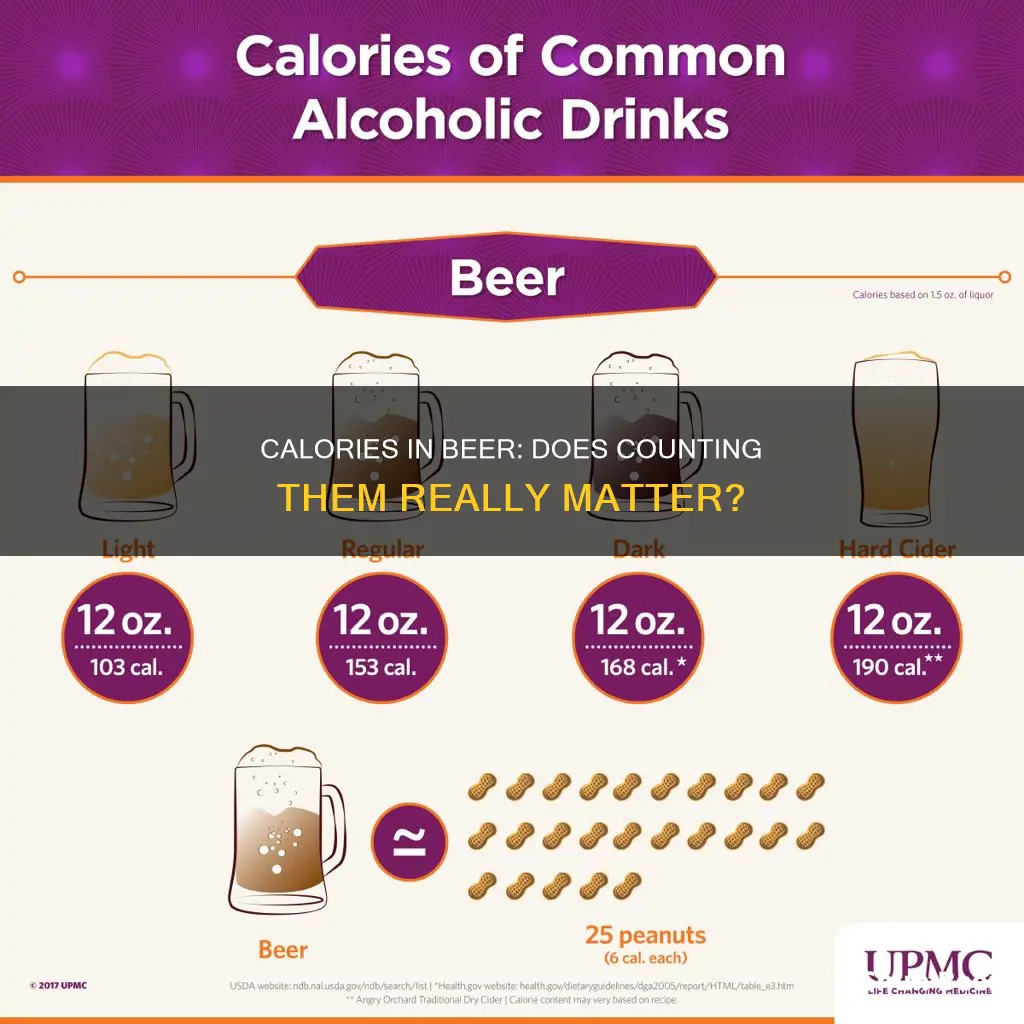
Beer is a popular drink worldwide, but how many calories are in it, and do these calories matter? Beer is made from fermented grain, and its calories mainly come from carbs and alcohol. The calorie content varies depending on the brew and the amount consumed. Generally, darker beers have more calories than lighter ones, and craft and seasonal beers tend to be higher in calories. Beer is often considered to have empty calories as it doesn't provide many nutrients. However, it does contain some healthy ingredients like brewer's yeast, barley, malt, and hops, as well as some vitamins and minerals. While beer can be part of a healthy diet when consumed in moderation, it's important to be mindful of the calorie content, especially when considering weight loss or maintaining a healthy weight.
What You'll Learn
- Beer is made from grains and is a source of carbohydrates
- Calories in beer depend on alcohol content and, to a lesser extent, carbs
- Beer is often called empty calories as it doesn't provide many nutrients
- Calorie count for a standard 12-ounce beer ranges from 95 to 150 calories
- Beer can be part of a healthy diet if consumed in moderation

Beer is made from grains and is a source of carbohydrates
Beer is made from grains, such as barley and wheat, and is therefore a source of carbohydrates. The number of carbohydrates in beer varies according to the fermentation process and the type of beer. For example, dark beers tend to have more carbohydrates than light beers due to the way they are brewed with added malts. A 12-ounce can of ale, lager, porter, premium beer, or stout has more than 12 grams of carbohydrates, while a light beer typically has around 3 grams.
The amount of carbohydrates in beer can be a concern for people watching their carbohydrate intake or following a low-carbohydrate diet. However, beer expert Charles Bamforth argues that beer, in moderation, can be part of a low-carb diet. He notes that most beers on the market contain relatively low levels of carbohydrates, and that alcoholic drinks with mixers such as ginger ale or cola tend to have higher levels of carbohydrates.
In addition to carbohydrates, beer also contains calories, with the number of calories depending mainly on the alcohol content and, to a lesser extent, the carbohydrate content. Craft, seasonal, and high-alcohol beers tend to have more calories than lighter beers. A typical 12-ounce beer has around 140 calories, similar to a can of Coke. However, some beers can have twice that amount.
When considering the health implications of beer, it is important to look at the overall calorie content rather than just the carbohydrate content. Beer can also contain vitamins, antioxidants, minerals, and fiber, although whole foods are better sources of these nutrients. For those watching their weight, opting for non-alcoholic beers or beers with lower alcohol content can be a good choice, as alcohol contributes more to the calorie content than carbohydrates.
Pale Ale Beer: Calorie Count and Nutrition Facts
You may want to see also

Calories in beer depend on alcohol content and, to a lesser extent, carbs
Beer is made from fermented grains such as barley and wheat, which contain carbohydrates. The number of grains and added sugars that remain in the beer varies according to the fermentation process. Therefore, the calorie content of beer depends on its alcohol and carbohydrate content.
A typical 12-ounce beer has around 140 calories, which is similar to a can of Coke. Some beers have as few as 60 calories, while others have up to 300 calories. Light beers with very low alcohol content (2% to 3% alcohol) tend to have fewer calories, with some lights (4% alcohol) containing about 100 calories. Regular beers with an average alcohol content of 5% have around 150 calories. Beers with higher alcohol content, such as IPAs, double IPAs, and Belgian-style Trippels, can have 200 to 300 calories.
The calorie content of beer also depends on the serving size. A 16- or 20-ounce draft pour of an average beer can contain 200 to 250 calories.
In addition to alcohol and carbs, the calorie content of beer can be affected by other ingredients such as added sugars. However, alcohol is the primary contributor to the calorie count in beer.
When it comes to calorie intake, it is important to moderate the quantity and stick to recommended healthy limits. For beer, it is recommended that men consume no more than two alcoholic beverages per day, while women should limit themselves to one alcoholic beverage per day.
Estrella Beer Calories: What's the Count?
You may want to see also

Beer is often called empty calories as it doesn't provide many nutrients
Beer is often referred to as "empty calories" because it provides little to no micronutrients, fibre, or protein. While beer does contain some vitamins and minerals, such as folate, niacin, magnesium, and potassium, the amount is negligible compared to the energy content of the drink.
The term "empty calories" refers to foods or beverages that are high in calories but low in nutritional value. These are typically composed primarily of calorie-rich macronutrients such as sugars and fats, with little to no micronutrients, fibre, or protein. Alcoholic beverages, including beer, fall into this category.
The refining processes used to make modern beers have stripped them of most of their nutritional value, leaving only trace amounts of vitamins and minerals that can be obtained from other sources. As a result, drinking beer can contribute to weight gain and malnutrition if consumed in excess.
Beer is made from grains, which can be healthy, but the fermentation process breaks down the starches and sugars, resulting in a drink that is high in calories and low in nutrients. The calories in beer come mainly from carbohydrates and alcohol, with a standard 12-ounce serving ranging from around 95 to 150 calories.
While beer can be part of a healthy diet when consumed in moderation, it is important to be mindful of the calorie content and stick to recommended limits. Excessive alcohol consumption can also lead to various short-term and long-term health risks, including injuries, alcohol poisoning, and an increased risk of certain cancers.
Calories in Sam Adams Cold Snap Beer Revealed
You may want to see also

Calorie count for a standard 12-ounce beer ranges from 95 to 150 calories
Calories are not the only consideration when it comes to beer, but they are an important factor for those watching their weight. The calorie count for a standard 12-ounce beer ranges from 95 to 150 calories, with some even reaching 153 calories. This is comparable to a can of Coke, which has a similar calorie count. Beer calories primarily come from alcohol and, to a lesser extent, carbohydrates. The higher the ABV, the more calories a beer will have. For example, a 12-ounce lager with 4.5% ABV has 135 calories, while a 10.5% barrel-aged stout of the same volume has 315 calories.
Craft beers, seasonal beers, and beers with higher alcohol content tend to have more calories than lighter beers. For instance, Budweiser, a regular 5% ABV beer, has around 150 calories, while Bud Light has only 110 calories. If you're watching your calorie intake, opting for light beers or alcohol-free options can be a good strategy. Very low-alcohol beers like Miller 64 have as few as 60 calories in a 12-ounce serving.
Beer is made from fermented grain, and the calories come mainly from the carbs and alcohol present. The sugar extracted from barley and grains causes fermentation, and more sugar means more alcohol and, consequently, more calories. While beer can be part of a healthy diet, it's important to moderate your intake and stick to recommended limits. Dietary guidelines suggest no more than two alcoholic drinks per day for men and no more than one per day for women to protect your liver and heart.
Calorie Count in Cobra Beer: What You Need to Know
You may want to see also

Beer can be part of a healthy diet if consumed in moderation
Beer has a reputation for being unhealthy, but when consumed in moderation, it can be part of a healthy diet.
Firstly, it's important to note that the calories in beer are not the only factor to consider when assessing its health benefits. Beer is made from natural ingredients such as barley, hops, yeast, and water, which contain important vitamins and minerals. These include vitamin B complex, folate, silicon, polyphenols, and other vitamins and minerals. Beer also has a healthy ratio of potassium to sodium, which helps maintain normal blood pressure.
Moderate alcohol consumption, defined as one drink per day for women and up to two drinks per day for men, has been linked to improved heart health. Additionally, beer contains more protein and B vitamins than wine, and its antioxidant content is equivalent. Beer is also a significant source of silicon, which can help prevent osteoporosis and protect the brain from compounds that cause cognitive diseases.
The number of calories in a beer depends on its alcohol and carbohydrate content. A typical 12-ounce beer has around 95 to 150 calories, with craft, seasonal, and high-alcohol beers tending to have more calories than lighter ones. Alcohol-free options usually contain fewer calories.
To include beer in a healthy diet, it's important to practice moderation and be mindful of your overall calorie intake. Strategies such as drinking a glass of water between alcoholic beverages, using pre-measured cups, and choosing low-calorie options can help. Additionally, pairing a strong IPA with a low-carb, high-protein dinner can balance your caloric intake.
In conclusion, beer can be part of a healthy diet when consumed in moderation. It provides essential nutrients, contributes to heart health, and may offer other benefits such as improved cognitive function and reduced inflammation. However, excessive consumption can have negative health consequences, so it is important to drink responsibly and consult with a healthcare professional if needed.
Calorie Count in Miller Lite Beer: What's the Damage?
You may want to see also
Frequently asked questions
The calorie count for a standard 12-ounce beer ranges from around 95 calories to just under 150 calories.
Beer tends to contain more calories than wine or spirits like whiskey. Cocktails and liquor are also higher in calories.
The calorie content of beer depends on the alcohol content and the amount of sugar and carbohydrates. Generally, the higher the ABV, the more calories in the beer.
It is often assumed that darker beers have more calories, but this is not always the case. Some dark beers have fewer calories than lighter beers.
Yes, there are several low-calorie beers available, including light beers and non-alcoholic beers, which tend to have fewer calories. Some specific examples include Bud Select, Michelob Ultra, and Coors Light.







